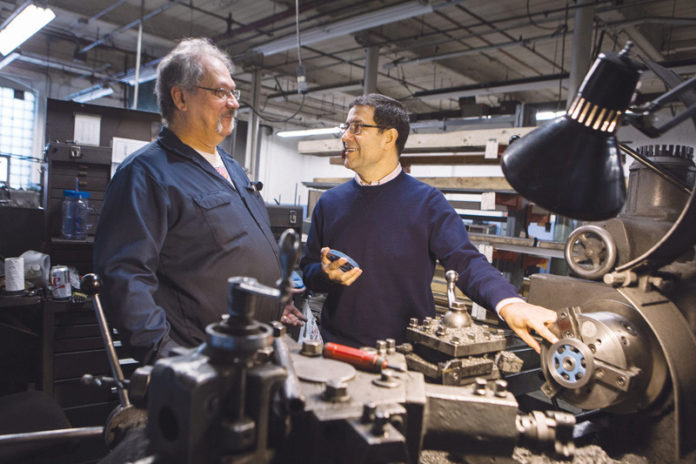
Wardwell Braiding Co., a 116-year-old manufacturer in Central Falls, has just 39 employees. Yet it sells its products in 47 states and 50 countries, and has sales offices in 27 countries with the help of a network of sales representatives.
Wardwell is the worldwide leader in building braiding machines that handle everything from textiles used in shoelaces and fishing lines to coaxial and shielded cables used for cable TV applications, computer networking and aerospace parts. Other uses include sail masts and skis, rear-window defrosters and medical catheters. It wasn’t always this way.
When the company was founded as Wardwell Braiding Machine Co. by Simon Wardwell in 1909, its machines were used to make braided textiles. Eventually, machinery for reinforced hose and composite structures were introduced, and since the 1970s, Wardwell has heavily invested in developing specialized braiding machines that serve the rapidly expanding needs of the wire and cable industry.
“Today our main market is the wire and cable industry,” said Wardwell Vice President John Tomaz. “We have literally tens of thousands of machines installed in customers’ plants around the world.”
As electronic devices have become smaller yet more powerful, it’s imperative to make the cables and components inside them smaller, requiring a more effective shielding. The company developed equipment that handles wire that is flat, round or elliptical and measures less than one-third the thickness of a strand of human hair. Wardwell machines allow for the braiding of as few as three strands – for something like a candle wick – to as many as 144 strands of Kevlar.
The company, still housed in its original facility, with 105,000 square feet of manufacturing space, has exported for decades. Tomaz said the company’s global exporting process is “seamless” and as simple as shipping products around New England.
But exports for the wire and cable industry as a whole slowed dramatically beginning in 2001, as more companies went overseas to do their manufacturing. The export decline was followed by stagnation that coincidentally subsided, Tomaz said, with Wardwell’s acquisition by Wilms Group in 2009.
Wardwell joined the German group, which includes other major equipment suppliers, in a move that not only helped it gain financial stability to invest in research and development, but also opened new opportunities around the world. As a result of the deal, over the past three years, Wardwell’s exports have grown more than 30 percent.
Tomaz said the larger companies Wardwell deals with put more stock in companies they know have the backing and stability to be around for a long time.
While joining the Wilms Group could be seen as a turning point for Wardwell’s export business, the company has not relied on that move alone to maintain its market share.
“We’re proactive in identifying emerging markets, emerging trends and staying on top of it so we can deliver the equipment that’s necessary,” said Tomaz, who has been with the company since 1978. “In some cases, providing what customers want, in others, actually anticipating and developing equipment customers don’t know they need yet,” he said.
Having an eye on all the regions of the world and emerging markets helped the company weather a slowdown in the European economy in recent years. “Most of the sales we used to get from Europe we get from other places,” he said, adding that the company has focused more internally in the United States, and China has been its biggest export market for years.
What the future holds for exports is uncertain. Tomaz said Asian markets are maturing and growth is slowing, while many companies are even re-shoring, needing increased security or quality control. Wardwell has been well-positioned to handle growth in South America, but despite chatter of growing opportunities there due to the large land mass and growing population, many companies opt to buy complete products rather than equipment to make their own.
“We’ve just never seen that take off,” he said, explaining the company’s choice to focus more on new trends than markets.
“The trends are important because they will drive the demand and the location where that takes place can change very quickly,” Tomaz said. “We suddenly notice all the companies operating in Asia are now beginning to pop up in new places like South America, or wherever the opportunities come from.”
Tomaz said Wardwell has a good amount of competition, but that it works to stay above the others, offering quality, industry-leading products at inexpensive prices.
“We’re trying to focus on where we can add value by delivering technological advances,” he said, “basically offering what other people cannot offer.” •












